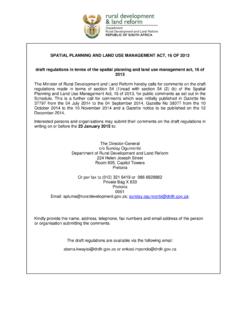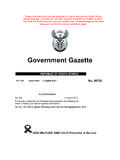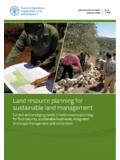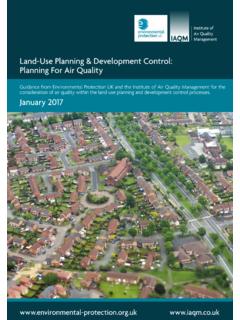Transcription of “How To” Planning Series How To… Link Land Use …
1 Strafford Regional Planning Commission 6:45 pm. Planning Board meeting night. Your thoughts are on the evening s agenda - packed again for the third month in a row. You review the list of items on the agenda: minor land subdivision, major land subdivision, preliminary site plan review for commercial development, public hearing for a residential subdivision of 25 units. You are concerned about the traffic impact from the residential development on a state highway and local roads. Also, you are wondering whether the newest proposed commercial development and related traffic issues will meet your Master Plan policies and implementation strategies. Nothing seems to be simple anymore. Over the last three decades, many communities in New Hampshire have become increasingly concerned about the amount and pace of growth in their community.
2 Populations are increasing and large tracts of open lands are being developed into residential subdivisions or strip-style commercial areas. Roads are being widened and new roads constructed, while bike trails, sidewalks, and other facilities that link activities and uses are not present in sufficient quantities. How do we want to grow and how can we plan better to achieve sustainable development that balances land use and transportation needs? How Link land Use and Transportation Planning The design of transportation facilities such as roads, driveway access points, sidewalks, and bike routes has a major impact on your community s character. These facilities are the result of land use decisions. This Guide provides informa-tion on linking land use decisions with transportation facilities Planning and development.
3 It describes which transpor-tation principles and strategies to use and how to incorporate them into the land use Planning process. It discusses the critical relationship Planning Boards have with New Hampshire Department of Transportation (NHDOT) in permitting driveways along state highways. It prepares you to work with applicants, NH DOT, and residents to achieve Master Plan goals. Introduction Table of Contents Introduction 1 Consider land Use and Transportation Issues Together 1 land Use Transportation Cycle 2 land Use Transportation Implementation Strategies 2 Nodal Development /Zoning 3 Livable Walkable Communities 3 Access Management 4 land Use Transportation and the Master Plan 5 land Use - Transportation Issues During Site Plan or Subdivision Plan Review 6 Local Role in Driveway Placement 7 land Use - Transportation Planning Must Be Linked!
4 8 Prepared by Strafford Regional Planning Commission. Funded by the NH Office of State Planning and the NH Department of Transportation How To Planning Series Town of Madbury: preserving rural character and considering new land use and transpor-tation needs. Consider land Use and Transportation Issues Together Better land use Planning can reduce our need for new roadways, and can make our infrastructure safer and more efficient. NH Department of Transportation The Transportation/ land Use Relationship, Citizen s Guide to Transportation. Series , 2003 Strafford Regional Planning Commission The land use-transportation cycle continues until it is physically or economically impossible to further expand highway capacity. Access Management, together with good land use control, can preserve highway capacity and effectively slow down or halt the development cycle. Federal Highway Administration Access Management Project In-creased Roadway improvements Increased land value Deterioration in level of service Increased traffic conflicts Increased traffic generation land Use Change The land Use Transportation Cycle How we use our land ( , for agriculture, residential, commer-cial, industrial development) impacts our transportation facilities, modes of travel ( , cars, buses, bicycles or walk-ing), services and vice versa.
5 This land use-transportation rela-tionship or cycle is illustrated by describing what commonly occurs when a road is built or improved. land along the road becomes more accessible. This increased accessibility makes the land more valuable and attractive to developers. As land along the road is developed, traffic volumes and the number of driveways increase. This results in more congestion and a deterioration of the road s capacity to efficiently move people and goods. The reduced efficiency of the road eventually necessitates roadway capacity improvements that may encour-age additional development and the start of a new cycle. Improved integration of land use and transportation Planning can reduce the need for highway expansion and maintain the quality of our communities. Three cost-effective strategies useful for integrating land use with transportation are: Nodal Development/Zoning, Livable Walkable Communities, and Access Management.
6 Individually or together, these strategies can significantly improve your community. Nodal Development/Zoning concentrates development ( , creates a village) to encourage walking or bicycle use so that land between nodes can be used for low density, low traffic land uses. Livable Walkable Communities are municipalities that provide facilities to promote walking, bicycling, services, and activities that promote a healthier lifestyle. Access Management is the ability to control the number and location of access points to a property. Adopting these strategies in your Master Plan as land use and transportation policies and in your Zoning Ordinance as devel-opment standards, and implementing them via site plan and subdivision plan review will significantly improve your commu-nity. The land Use Transportation Cycle The average single family household gener-ates approximately 10 vehicle trips per day.
7 A street with 30 houses would gener-ate an estimated 300 vehicle trips per day. The average commercial drive-through fast-food restaurant generates approximately 496 vehicle trips per day per 1,000 sq. ft. of gross floor area. The average office generates approximately trips per employee per day. (Trip Generation Manual, 1997) Page 2 land Use - Transportation Implementation Strategies Strafford Regional Planning Commission How To Planning Series Nodal development/zoning is a concentration of land uses around an existing intersection or village center that serves as a focal point for the community. Focusing development in nodes while maintaining open space between them accomplishes two goals. First, it helps maintain the desirable traditional New England community character. Second, it preserves traffic flow by reducing the number of potential conflicts along the roadway or corridor.
8 Nodal development areas are identified in a community s Master Plan land use section and promoted via a zoning ordinance district and development standards. The Town of Wakefield has included nodal development/zoning principles in its Master Plan and in its Zoning Ordinance. The Town of New Durham participated in the Route 11 Access Management Planning Study with Rochester and Farmington. They are considering promoting nodal development by adopting nodal zones in key areas. The Route 16 Corridor Study suggests using nodal development as one of five strategies for managing land use development and transportation. With compact development the share of trips made by other transportation modes can be higher and typical trip length can be shorter. The end result are corridors better planned to meet goals. Nodal Development / Zoning Town of Wakefield: Nodal zoning along the NH 16 Corridor In many communities across the country, streets designed over the past fifty years have placed the needs of the motorist fore-most, making it unsafe for people walking or biking.
9 This has often created stark, wide and fast roads that aim to respond only to the needs of motorists and that do not support healthy lifestyles. Communities that adopt street design standards to include side-walks separate from the road way and to accommodate bicyclists, create safer, more pleasant environments for every-one. Requiring both commercial and residential developers to incorporate bicycle and pedestrian walkways in their plans can significantly improve and maintain rural, small town character by decreasing the amount of vehicle trips. Trails, sidewalks, and space for bicycles create multiple modes of connectivity main-taining viable and diverse opportunities for development. Livable Walkable Communities Town of Barrington: Nodal development Safe pedestrian walkway adjacent to street Page 3 Strafford Regional Planning Commission Access Management Issues Strategies Distance between Driveways Require minimum distance between driveways based on the speed limit of the roadway consistent with FHWA guidance documented in Access Management for Streets and Roads FHWA, 1982.
10 Driveway Ownership Require shared driveways whenever feasible. Number of Driveways Limit the number of driveways per lot to minimize the conflict points on the roadway. Frontage Roads Where feasible, encourage using of frontage roads to maintain traffic flow. Interconnection between Developments Where feasible, provide connection between parcels to limit the need for traffic to reenter the roadway. Access Management Access Management is implementing a set of Planning strategies to ensure the safe and efficient flow of traffic, while maintaining the character of a community. Access Management strategies include: spacing and design of driveways, median openings, and interchanges; placement of abutting parking facilities; and use of instructional signage. Using Access Management strategies enables a community to maintain safety and quality of life for their residents and visitors.







